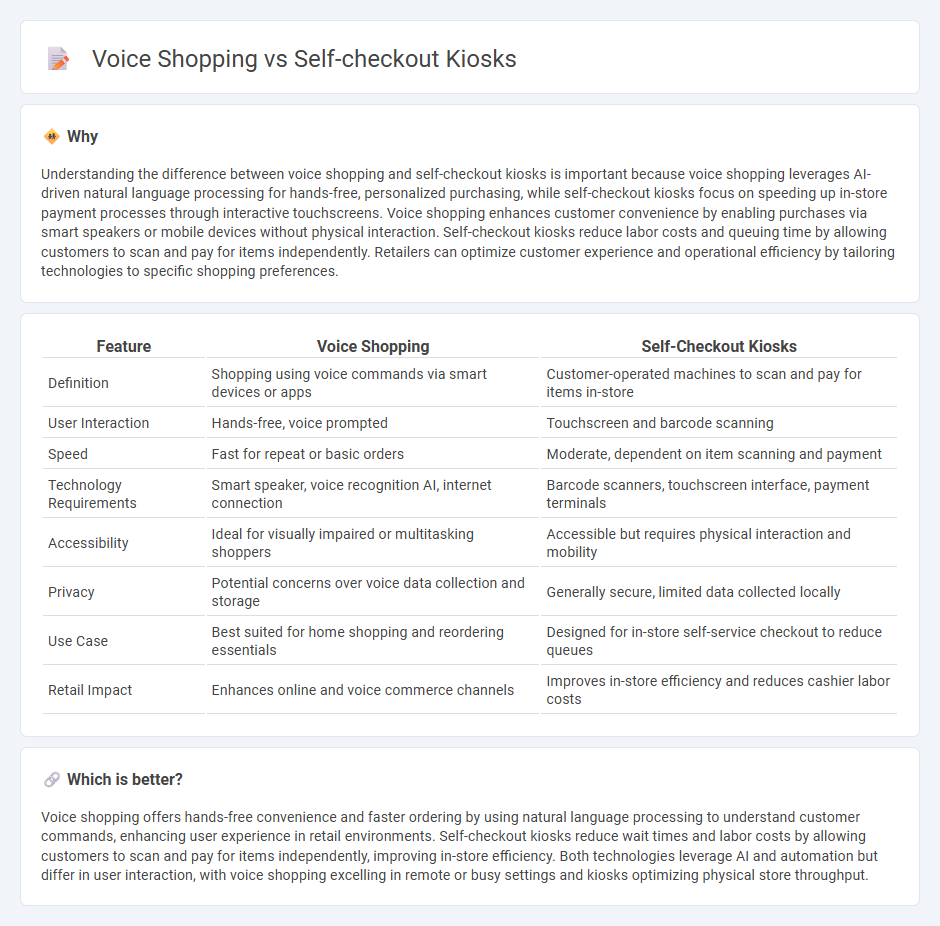
Voice shopping leverages AI-powered virtual assistants to enable hands-free, conversational transactions that streamline the customer experience by offering personalized product recommendations and quick checkout processes. Self-checkout kiosks provide a physical, touch-based solution that reduces wait times and increases convenience by allowing shoppers to scan and pay for items independently, enhancing in-store efficiency. Explore how these innovative retail technologies are transforming consumer behavior and operational workflows.
Why it is important
Understanding the difference between voice shopping and self-checkout kiosks is important because voice shopping leverages AI-driven natural language processing for hands-free, personalized purchasing, while self-checkout kiosks focus on speeding up in-store payment processes through interactive touchscreens. Voice shopping enhances customer convenience by enabling purchases via smart speakers or mobile devices without physical interaction. Self-checkout kiosks reduce labor costs and queuing time by allowing customers to scan and pay for items independently. Retailers can optimize customer experience and operational efficiency by tailoring technologies to specific shopping preferences.
Comparison Table
| Feature | Voice Shopping | Self-Checkout Kiosks |
|---|---|---|
| Definition | Shopping using voice commands via smart devices or apps | Customer-operated machines to scan and pay for items in-store |
| User Interaction | Hands-free, voice prompted | Touchscreen and barcode scanning |
| Speed | Fast for repeat or basic orders | Moderate, dependent on item scanning and payment |
| Technology Requirements | Smart speaker, voice recognition AI, internet connection | Barcode scanners, touchscreen interface, payment terminals |
| Accessibility | Ideal for visually impaired or multitasking shoppers | Accessible but requires physical interaction and mobility |
| Privacy | Potential concerns over voice data collection and storage | Generally secure, limited data collected locally |
| Use Case | Best suited for home shopping and reordering essentials | Designed for in-store self-service checkout to reduce queues |
| Retail Impact | Enhances online and voice commerce channels | Improves in-store efficiency and reduces cashier labor costs |
Which is better?
Voice shopping offers hands-free convenience and faster ordering by using natural language processing to understand customer commands, enhancing user experience in retail environments. Self-checkout kiosks reduce wait times and labor costs by allowing customers to scan and pay for items independently, improving in-store efficiency. Both technologies leverage AI and automation but differ in user interaction, with voice shopping excelling in remote or busy settings and kiosks optimizing physical store throughput.
Connection
Voice shopping leverages natural language processing to enable hands-free product searches and purchases, streamlining the customer journey. Self-checkout kiosks complement this technology by offering quick, autonomous payment solutions that reduce wait times and enhance convenience. Together, they create an integrated retail ecosystem focused on efficiency and personalized consumer experiences.
Key Terms
User Interface
Self-checkout kiosks feature touchscreen interfaces designed for direct user interaction, offering intuitive navigation and visual feedback that streamlines the purchasing process. Voice shopping relies on advanced natural language processing, allowing users to make purchases through verbal commands, which enhances accessibility but may face challenges in understanding diverse accents and complex queries. Explore how these user interface approaches impact shopping efficiency and customer satisfaction.
Transaction Speed
Self-checkout kiosks offer rapid transaction speeds by allowing shoppers to scan and pay for items independently, reducing wait times significantly in retail environments. Voice shopping leverages AI assistants to process orders quickly, though transaction speed can be influenced by speech recognition accuracy and internet connectivity. Explore the latest advancements in transaction efficiency for both shopping technologies to optimize customer experience.
Customer Experience
Self-checkout kiosks enhance the in-store customer experience by reducing wait times and providing intuitive touch-based interfaces, optimizing convenience for tech-savvy shoppers. Voice shopping leverages AI assistants like Amazon Alexa and Google Assistant to offer hands-free, personalized, and seamless transactions, increasing accessibility for busy or visually impaired customers. Explore how integrating these technologies can transform your retail strategy and elevate customer satisfaction.
Source and External Links
Self-Checkout Kiosks - Advanced self-checkout kiosks use AI-powered camera vision technology to recognize items without barcodes, enabling fast, touchless payments and integration with existing POS and loyalty systems for retail and hospitality environments.
Self Service Kiosks | Elo(r) Official Website - Self-service kiosks enhance customer experience by reducing wait times, increasing order accuracy and size, and freeing staff for higher-value tasks, with modular designs adaptable to various retail and hospitality settings.
How Much Do Self Checkout Machines Cost - Self-checkout machines empower customers with greater control over transactions and improve efficiency, especially with RFID technology that scans multiple items at once to minimize errors and speed up checkout.
 dowidth.com
dowidth.com